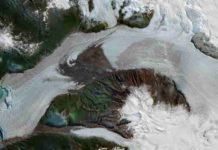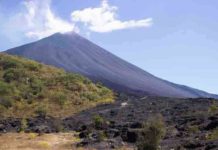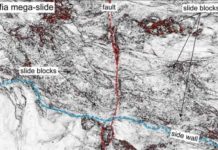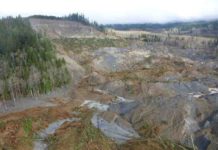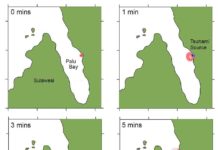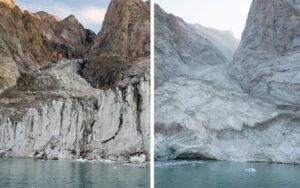
A landslide in a remote part of Greenland caused a mega-tsunami that sloshed back and forth across a fjord for nine days, generating vibrations throughout Earth, according to a new study involving UCL researchers.
The study, published in the journal Science, concluded that this movement of water was the cause of a mysterious, global seismic signal that lasted for nine days and puzzled seismologists in September 2023.
The initial event, not observed by human eye, was the collapse of a 1.2km-high mountain peak into the remote Dickson Fjord beneath, causing a backsplash of water 200 metres in the air, with a wave up to 110 metres high. This wave, extending across 10km of fjord, reduced to seven metres within a few minutes, the researchers calculated, and would have fallen to a few centimetres in the days after.
The team used a detailed mathematical model, recreating the angle of the landslide and the uniquely narrow and bendy fjord, to demonstrate how the sloshing of water would have continued for nine days, with little energy able to escape.
The model predicted that the mass of water would have moved back and forth every 90 seconds, matching the recordings of vibrations travelling in the Earth’s crust all around the globe.
The landslide, the researchers wrote, was a result of the glacier at the foot of the mountain thinning, becoming unable to hold up the rock-face above it. This was ultimately due to climate change. The landslide and tsunami were the first observed in eastern Greenland.
Co-author Dr Stephen Hicks, of UCL Earth Sciences, said: “When I first saw the seismic signal, I was completely baffled. Even though we know seismometers can record a variety of sources happening on Earth’s surface, never before has such a long-lasting, globally travelling seismic wave, containing only a single frequency of oscillation, been recorded. This inspired me to co-lead a large team of scientists to figure out the puzzle.
“Our study of this event amazingly highlights the intricate interconnections between climate change in the atmosphere, destabilisation of glacier ice in the cryosphere, movements of water bodies in the hydrosphere, and Earth’s solid crust in the lithosphere.
“This is the first time that water sloshing has been recorded as vibrations through the Earth’s crust, travelling the world over and lasting several days.”
The mysterious seismic signal — coming from a vibration through the Earth’s crust — was detected by seismometers all over the globe, from the Arctic to Antarctica. It looked completely different to frequency-rich ‘rumbles’ and ‘pings’ from earthquake recordings, as it contained only a single vibration frequency, like a monotonous-sounding hum.
When the study’s authors first discovered the signal, they made a note of it as a “USO”: unidentified seismic object.
At the same time, news of a large tsunami in a remote northeast Greenland fjord reached authorities and researchers working in the area.
The researchers joined forces in a unique multidisciplinary group involving 68 scientists from 40 institutions in 15 countries, combining seismometer and infrasound data, field measurements, on-the-ground and satellite imagery, and simulations of tsunami waves.
The team also used imagery captured by the Danish military who sailed into the fjord just days after the event to inspect the collapsed mountain-face and glacier front along with the dramatic scars left by the tsunami.
It was this combination of local field data and remote, global-scale observations that allowed the team to solve the puzzle and reconstruct the extraordinary cascading sequence of events.
Lead author Dr Kristian Svennevig, from the Geological Survey of Denmark and Greenland (GEUS), said: “When we set out on this scientific adventure, everybody was puzzled and no one had the faintest idea what caused this signal. All we knew was that it was somehow associated with the landslide. We only managed to solve this enigma through a huge interdisciplinary and international effort.”
He added: “As a landslide scientist, an additional interesting aspect of this study is that this is the first-ever landslide and tsunami observed from eastern Greenland, showing how climate change already has major impacts there.”
The team estimated that 25 million cubic metres of rock and ice crashed into the fjord (enough to fill 10,000 Olympic-sized swimming pools).
They confirmed the size of the tsunami, one of the largest seen in recent history, using numerical simulations as well as local data and imagery.
Seventy kilometres away from the landslide, four-metre-high tsunami waves damaged a research base at Ella Ø (island) and destroyed cultural and archaeological heritage sites across the fjord system.
The fjord is on a route commonly used by tourist cruise ships visiting the Greenland fjords. Fortunately, no cruise ships were close to Dickson Fjord on the day of the landslide and tsunami, but if they had been, the consequences of a tsunami wave of that magnitude could have been devastating.
Mathematical models recreating the width and depth of the fjord at very high resolution demonstrated how the distinct rhythm of a mass of water moving back and forth matched the seismic signal.
The study concluded that with rapidly accelerating climate change, it will become more important than ever to characterise and monitor regions previously considered stable and provide early warning of these massive landslide and tsunami events.
Co-author Thomas Forbriger, from Karlsruhe Institute of Technology, said: “We wouldn’t have discovered or been able to analyse this amazing event without networks of high-fidelity broadband seismic stations around the world, which are the only sensors that can truly capture such a unique signal.”
Co-author Anne Mangeney, from Université Paris Cité, Institut de Physique du Globe de Paris, said: “This unique tsunami challenged the classical numerical models that we previously used to simulate just a few hours of tsunami propagation. We had to go to an unprecedentedly high numerical resolution to capture this long-duration event in Greenland. This opens up new avenues in the development of numerical methods for tsunami modelling.”
Reference:
Kristian Svennevig, Stephen P. Hicks, Thomas Forbriger, Thomas Lecocq, Rudolf Widmer-Schnidrig, Anne Mangeney, Clément Hibert, Niels J. Korsgaard, Antoine Lucas, Claudio Satriano, Robert E. Anthony, Aurélien Mordret, Sven Schippkus, Søren Rysgaard, Wieter Boone, Steven J. Gibbons, Kristen L. Cook, Sylfest Glimsdal, Finn Løvholt, Koen Van Noten, Jelle D. Assink, Alexis Marboeuf, Anthony Lomax, Kris Vanneste, Taka’aki Taira, Matteo Spagnolo, Raphael De Plaen, Paula Koelemeijer, Carl Ebeling, Andrea Cannata, William D. Harcourt, David G. Cornwell, Corentin Caudron, Piero Poli, Pascal Bernard, Eric Larose, Eleonore Stutzmann, Peter H. Voss, Bjorn Lund, Flavio Cannavo, Manuel J. Castro-Díaz, Esteban Chaves, Trine Dahl-Jensen, Nicolas De Pinho Dias, Aline Déprez, Roeland Develter, Douglas Dreger, Läslo G. Evers, Enrique D. Fernández-Nieto, Ana M. G. Ferreira, Gareth Funning, Alice-Agnes Gabriel, Marc Hendrickx, Alan L. Kafka, Marie Keiding, Jeffrey Kerby, Shfaqat A. Khan, Andreas Kjær Dideriksen, Oliver D. Lamb, Tine B. Larsen, Bradley Lipovsky, Ikha Magdalena, Jean-Philippe Malet, Mikkel Myrup, Luis Rivera, Eugenio Ruiz-Castillo, Selina Wetter, Bastien Wirtz. A rockslide-generated tsunami in a Greenland fjord rang Earth for 9 days. Science, 2024; 385 (6714): 1196 DOI: 10.1126/science.adm9247
Note: The above post is reprinted from materials provided by University College London.





